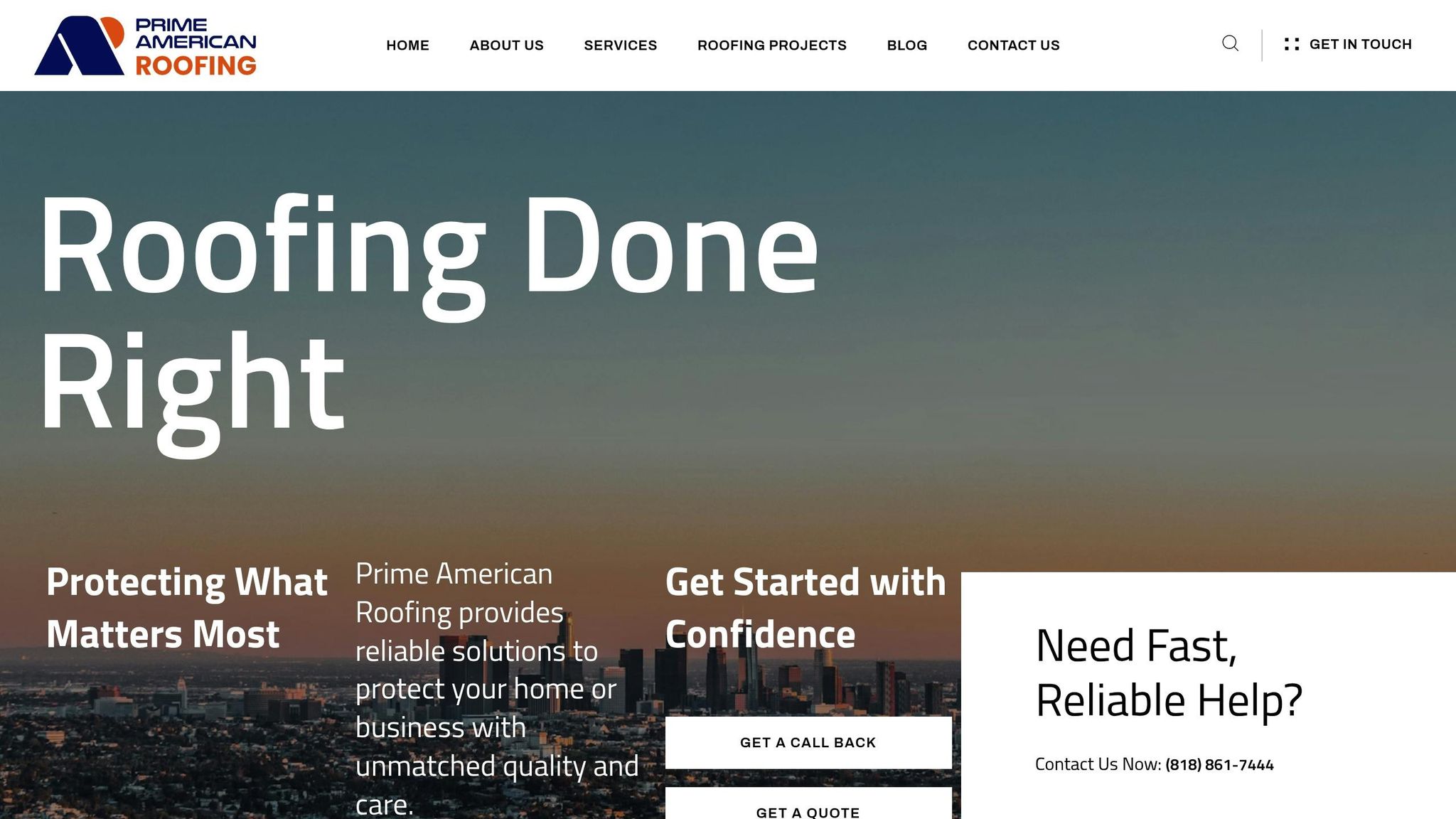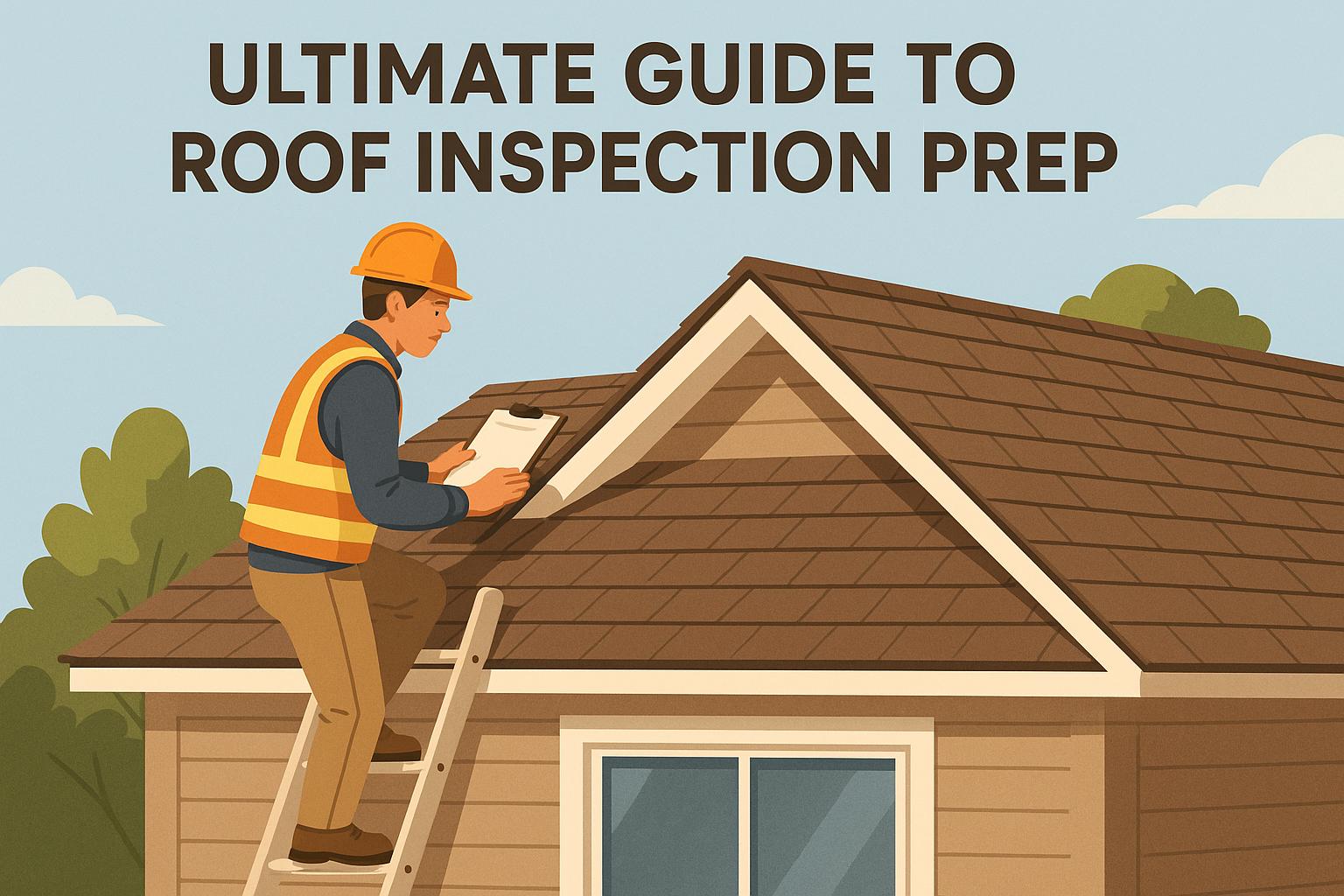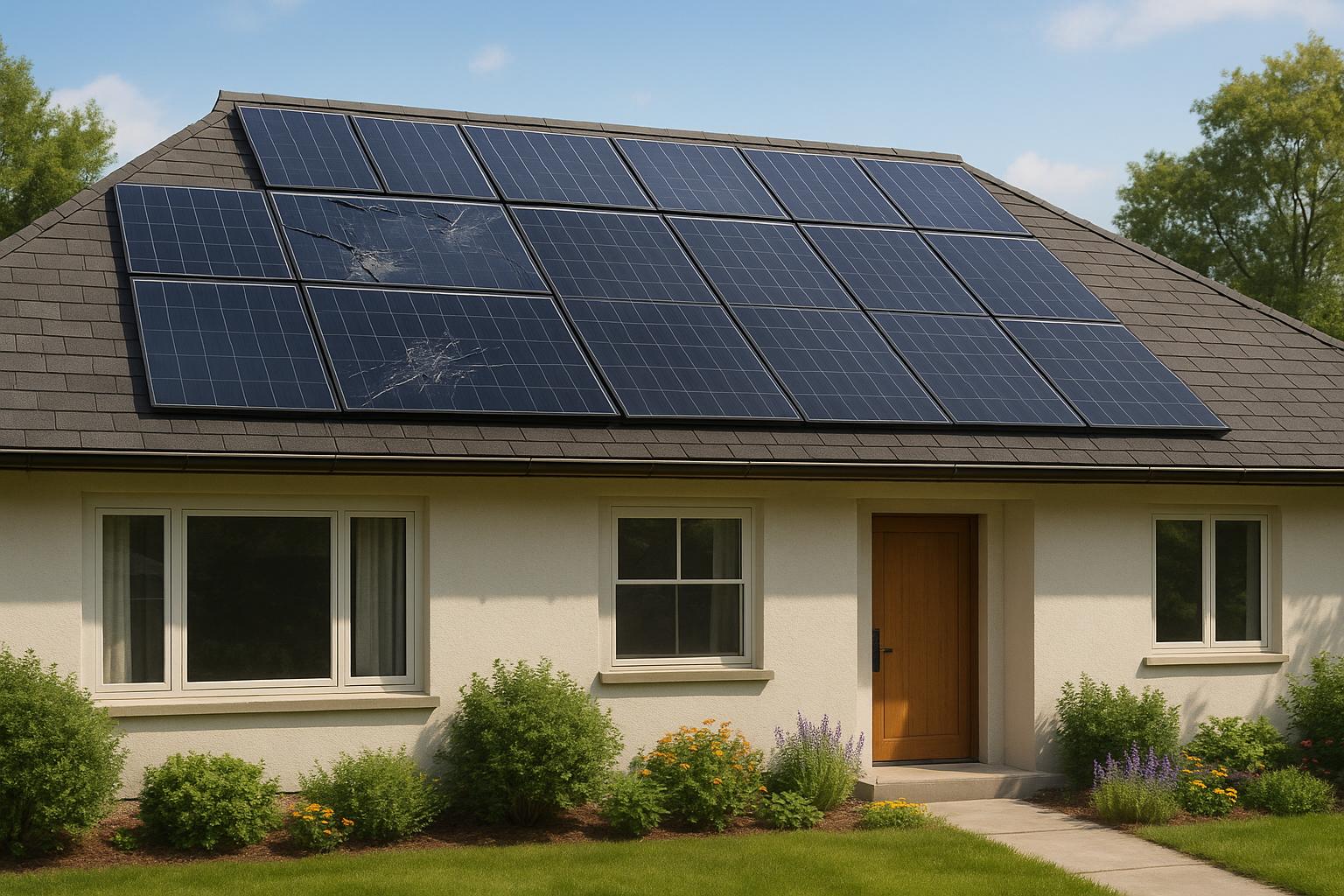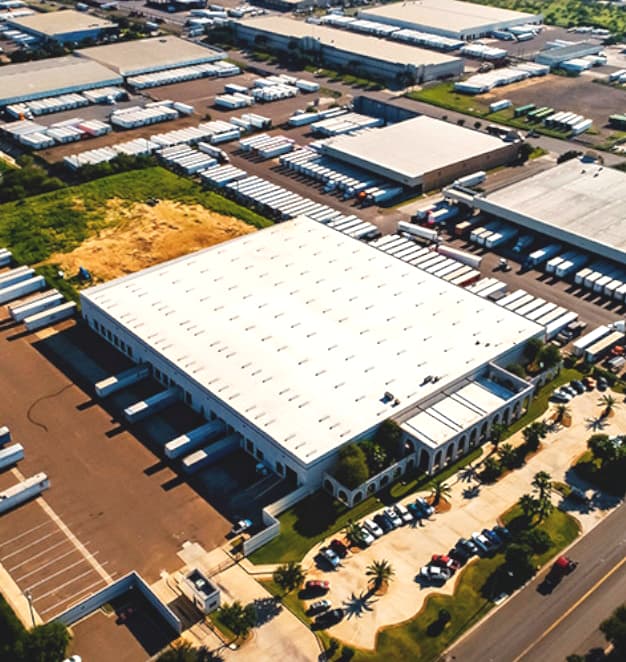Your roof protects your home, but small issues can lead to big problems if ignored. Here’s how to prepare for a roof inspection, what to expect during it, and what to do after:
- Preparation: Gather past inspection reports, maintenance records, and warranty details. Clean your roof and surrounding areas for easy access and ensure safety pathways are clear.
- Inspection Focus Areas: Inspectors check your roof’s surface, flashing, vents, gutters, and look for indoor signs like water stains or mold.
- Post-Inspection: Review the detailed report with photos and repair priorities. Address urgent issues like leaks or structural concerns immediately.
Pro Tip: If you’re in Southern California, Prime American Roofing offers free inspections with expert advice to keep your roof in top shape.
Taking these steps ensures a thorough evaluation, helps prevent costly repairs, and extends your roof’s lifespan.
How Does an EXPERT Roofer Do a Roof Inspection | TSM …
Getting Ready for Your Inspection
Proper preparation for an inspection involves organizing documents, tidying up the area, and ensuring safety protocols are in place. This helps the process run smoothly and allows for a thorough evaluation.
Collecting Important Documents
Having the right paperwork ready helps inspectors review your roof’s history. Make sure to gather:
- Previous inspection reports: These provide a comparison point for current conditions.
- Maintenance records: Proof of past repairs and upkeep.
- Warranty details: Information about your current coverage.
Organize these documents so they’re easy to find when needed.
Cleaning the Roof and Surrounding Area
Remove any debris or obstacles from the roof and the area around it. A clean space ensures the inspector can access everything they need without unnecessary delays.
Ensuring Safety
Make sure all pathways to the roof are clear of hazards. Prime American Roofing follows a strict pre-inspection checklist and uses top-notch safety equipment to keep the inspection process safe for everyone involved.
What Gets Inspected
Inspectors focus on crucial areas to spot potential problems early.
Roof Surface Condition
Key factors include:
- Shingles: Look for cracked, curled, or missing shingles.
- Surface wear: Check for excessive granule loss or unusual wear patterns.
- Material condition: Assess the flexibility and overall state of roofing materials.
- Structural problems: Watch for sagging, warping, or uneven surfaces.
Flashing and Vent Check
Inspectors pay close attention to:
- Chimney flashing: Ensure proper sealing and condition.
- Vent pipe seals: Check seals and surrounding flashing for damage.
- Water flow in valleys: Confirm water is being channeled correctly.
- Skylight seals: Inspect the perimeter for gaps or wear.
Gutter System Review
A thorough gutter check includes:
- Slope and attachment: Ensure gutters are securely attached and angled correctly.
- Water discharge: Verify proper installation for effective water flow.
- Blockages: Identify areas prone to clogging.
- Seams and corners: Look for leaks or weak points.
Indoor Warning Signs
Inside the home, inspectors look for:
- Attic issues: Assess ventilation, water intrusion, insulation quality, and signs of mold.
- Ceilings: Check for water stains, bubbling paint, or discoloration.
- Walls: Look for moisture damage, peeling wallpaper, or paint deterioration.
These evaluations help you understand the inspection report and prioritize necessary repairs.
sbb-itb-d1d6490
After Your Inspection
Understanding Your Report
Once your inspection is complete, you’ll receive a detailed report outlining key findings. This report usually includes:
- Condition ratings: A breakdown of the current state of each roof component.
- Photo documentation: Clear images highlighting problem areas and potential risks.
- Repair priorities: A list of issues organized by urgency, from critical to routine maintenance.
- Professional recommendations: Expert advice on necessary repairs and ongoing upkeep.
Pay close attention to items marked as needing "immediate attention" or flagged as "safety concerns." These are the issues that, if ignored, could lead to more significant damage or safety risks. Use this information to decide what repairs need to be handled first.
Planning Repairs
Once you’ve reviewed your report, it’s time to create a repair plan.
Emergency Repairs: These require urgent action to prevent further damage or address safety risks. Examples include:
- Active leaks
- Structural problems
- Safety hazards
- Severe damage
Maintenance Repairs: These are less urgent but still important for extending the life of your roof. Examples include:
- Fixing small shingle issues
- Adjusting gutters
- Applying preventive sealing
- Improving ventilation
Prime American Roofing Services

Our Service Range
Prime American Roofing offers a wide range of roofing services throughout Southern California. We specialize in detailed roof inspections for both residential and commercial properties. These inspections help pinpoint potential problems and guide maintenance decisions. Our services also include roof installation, repairs, regular maintenance, emergency fixes, as well as gutter and solar panel installations. Every service is backed by our strict quality standards.
Quality Standards
Our commitment to quality starts with teamwork. Tony Mirzakhanyan, Head of Prime American Roofing, emphasizes:
"Working in a professional and responsible team is essential for delivering high-quality roofing services. Collaboration ensures that each aspect of the project, from initial assessment to final installation, is executed with precision and expertise"
Thorough inspections are the cornerstone of effective roof maintenance. We maintain high standards through:
| Component | What We Deliver |
|---|---|
| Materials | Durable, weather-resistant products |
| Workmanship | Skilled and precise craftsmanship |
| Documentation | Detailed inspection reports with photos |
| Follow-up | Post-service quality checks |
| Support | Warranty coverage for peace of mind |
These standards apply to all our services, including our complimentary inspection program.
Free Inspection Program
Take advantage of our free roof inspection to understand your roof’s condition and ensure it stays in top shape. This service includes a full exterior evaluation, complete with photo documentation and a written report featuring professional recommendations.
"Prime American Roofing provides reliable solutions to protect your home or business with unmatched quality and care." – Prime American Roofing
Contact our team today to schedule your free inspection and get expert guidance on maintaining your roof.
Summary
Proper preparation and timely reviews are essential for keeping your roof in good shape. Before scheduling a roof inspection, gather repair records and warranty details. Make sure the roof is clean and easy to access so the evaluation can be thorough.
Annual inspections are a smart way to catch problems early. Key areas to check during an inspection include:
| Component | What to Look For |
|---|---|
| Surface | Condition of materials, wear |
| Flashing | Seals and overall integrity |
| Gutters | Drainage and secure attachment |
| Interior | Signs of water damage |
After the inspection, go over the detailed report and prioritize any recommended fixes. Tackling small issues early can save you from more expensive repairs down the road.
If you’re in Southern California, Prime American Roofing offers a free inspection program. Their evaluations and expert advice can help ensure your roof stays strong and reliable.
Rely on professional expertise to protect your roof and your property investment. It’s a practical step to extend your roof’s lifespan and keep it performing at its best.
FAQs
How can I properly prepare my roof for a professional inspection?
Preparing your roof for a professional inspection is simple and ensures the process goes smoothly. Start by clearing any debris, such as leaves or branches, from your roof and gutters. This allows the inspector to easily assess the condition of your roof and drainage system.
If possible, check your attic for signs of water damage, mold, or leaks, as these can provide valuable insights during the inspection. Make sure to also inform the inspector of any specific concerns you may have noticed, like missing shingles or unusual noises during storms. Regular maintenance and inspections are key to prolonging your roof’s lifespan and catching potential issues early.
How do I know which roof repairs need immediate attention and which can wait?
Determining which roof repairs are urgent starts with understanding the severity of the issue. Problems like active leaks, missing shingles, or structural damage should be addressed immediately, as they can lead to further damage and costly repairs if left unchecked. On the other hand, minor cosmetic issues or small cracks in non-critical areas may not require immediate action but should still be monitored.
A professional roof inspection can help you prioritize repairs by identifying urgent issues and recommending a timeline for less critical fixes. Regular inspections and maintenance are key to extending the life of your roof and avoiding unexpected problems down the line.
What information does a roof inspection report include, and how can it help with maintenance planning?
A roof inspection report provides a detailed evaluation of your roof’s current condition, including any damage, wear, or areas that may need attention. It typically highlights issues like leaks, missing shingles, structural concerns, or drainage problems.
This report is essential for planning maintenance because it helps you prioritize repairs, estimate costs, and prevent small issues from turning into costly problems. Scheduling regular inspections, ideally once a year, ensures your roof remains in good shape and extends its lifespan.





